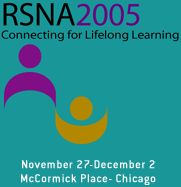
Abstract Archives of the RSNA, 2005
SSC12-05
Effect of Neuroaxial Injections on Magnetic Resonance Imaging: A Prospective Study Comparing Lumbar Spinal MRI prior to Epidural Injection with MRI Following Injection in Patients Treated for Low Back Pain
Scientific Papers
Presented on November 28, 2005
Presented as part of SSC12: Neuroradiology/Head and Neck (Spine: Degenerative Disease)
Rachel Beth Hulen MD, Presenter: Nothing to Disclose
Elyad M Davidson MD, Abstract Co-Author: Nothing to Disclose
Evelyn M. Sklar MD, Abstract Co-Author: Nothing to Disclose
Rita G. Bhatia MD, Abstract Co-Author: Nothing to Disclose
Sharon Salenius, Abstract Co-Author: Nothing to Disclose
Daryl Eber MD, Abstract Co-Author: Nothing to Disclose
David Birnbach, Abstract Co-Author: Nothing to Disclose
et al, Abstract Co-Author: Nothing to Disclose
To determine the expected MRI findings after lumbar spinal epidural injection in uncomplicated patients.
Ten patients receiving epidural injection for pain relief at the pain clinic were prospectively enrolled in the study. Patients received an MRI of the lumbar spine prior to injection. Injections were then performed by an anesthesiologist under fluoroscopic guidance into the epidural space. Documentation was made of the level of entry, the amount injected, and unusual clinical symptoms. Patients then had an MRI within six hours of the injection. The MRI images were reviewed by two neuroradiologists who were blinded as to the time at which the MRI was performed in relation to the injection. The evaluators compared the two MRI studies and evaluated for the presence of epidural fluid collections, air, and hemorrhage. The evaluators also stated if they felt an epidural injection preceded the MRI study and if they could identify an injection track. The data was analyzed to determine the MRI findings following routine administration of epidural anesthesia.
The readers were able to correctly identify if the study was before or after the injection 80% of the time. An injection track was seen in 66-77% of the studies that were performed after injection. A small amount of air was seen in 66-77% of patients after injection. The gradient echo sequence was identified as the most useful for making these findings. The largest collection was of epidural air measuring 8mm x 7mm with minimal indentation on the thecal sac. There were no fluid collections or hematomas and there was no significant mass effect on the subarachnoid sac by any of the findings. None of the patients experienced any new symptoms after the injection.
In the majority of patients who underwent an epidural injection, MRI findings were present which indicated to the reader that the injection has been performed. However, there were no findings of any significant collections after uncomplicated injection. Thus the presence of such findings in patients who develop new symptoms after injection should be considered pathologic in the appropriate clinical setting.
Hulen, R,
Davidson, E,
Sklar, E,
Bhatia, R,
Salenius, S,
Eber, D,
Birnbach, D,
et al, ,
Effect of Neuroaxial Injections on Magnetic Resonance Imaging: A Prospective Study Comparing Lumbar Spinal MRI prior to Epidural Injection with MRI Following Injection in Patients Treated for Low Back Pain. Radiological Society of North America 2005 Scientific Assembly and Annual Meeting, November 27 - December 2, 2005 ,Chicago IL.
http://archive.rsna.org/2005/4418514.html

